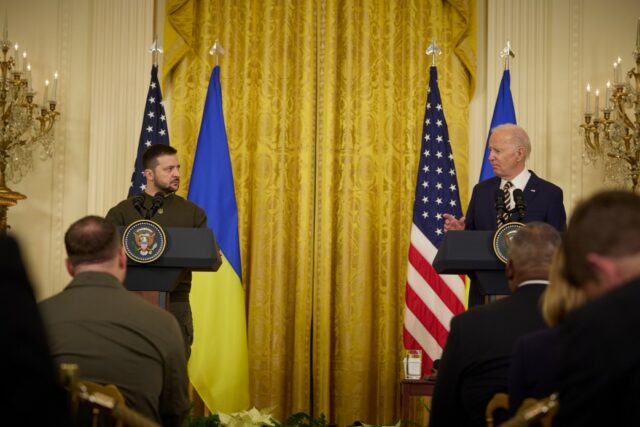
The Case for US Assent to Ukraine’s Further Dismemberment (Part Two)
Publication: Eurasia Daily Monitor Volume: 20 Issue: 25
By:

*Read Part One Here.
Ukraine’s leadership and public opinion are adamant in ruling out land-for-peace tradeoffs with Russia. Leadership statements and public opinion surveys testify to this attitude. Such tradeoffs have, nevertheless, been proposed in a recent RAND Corporation report (Rand.org, January 2023).
Ukrainian territorial concessions to Russia, the paper suggests, would, of necessity, encompass territories seized by Russia in both invasions (2014–2015 and 2022–2023). But, according to the RAND report, Russian territorial gains from any tradeoffs need not be codified de jure. They could be framed as de facto renunciation by Ukraine in return for an end to the war and without official Western recognition of Russia’s annexations. As in the case of Crimea from 2014 onward, the United States and its allies would treat Russia’s seizure of further Ukrainian territories as illegitimate and illegal. This clearly alludes to Donbas, the Russian-occupied parts of the Zaporizhzhia and Kherson provinces and potentially anything Russia might yet seize from Ukraine, “regardless of where the de facto lines are drawn.”
According to the paper, the actual amount of land illegally seized is of secondary importance. What matters more is that the forcible territorial changes should not receive official acceptance at the international level. With Moscow in violation of the territorial integrity norm in Ukraine since 2014, the argument goes, Russia would not necessarily do more harm to the international order if it keeps some of the territories it gained in 2022. Either way, Russia would control some Ukrainian territories in violation of this territorial integrity norm. The implication is that Ukraine pushing back to the lines before Russia’s re-invasion on February 24, 2022, would scarcely mitigate the damage to those “norms” and might, by implication, not be worth continuing a Ukrainian war of liberation.
The authors are concerned with preserving “international norms” on the territorial integrity of states and the inadmissibility of border changes through force. They proceed from the US interest in reinforcing those norms as enshrined in international law. But the recommendations offered would preserve those norms in outward appearance only. The claim that Washington (the West) imposed a “steep price” on Moscow in 2014 weakens the case further. And far from constituting a “powerful pushback,” de facto acceptance of territorial grabs could encourage, rather than discourage, further violations by Russia and others. Acceptance under a cover of non-acceptance de jure, and accompanied by sanctimonious rhetoric, would look hypocritical to the interested parties, bystanders and violators alike.
By that logic, an armistice that would freeze the existing frontlines cutting across Ukraine would not result in undermining those “norms” in international law as long as the conquests are unrecognized de jure. The paper envisions an armistice whereby Russia would stop its attempts to occupy additional Ukrainian territories and would cease missile strikes on Ukrainian civilian targets. Ukraine, for its part, would stop any counteroffensives of its forces aimed at regaining Russian-held Ukrainian territories. The issues of territories and borders between Ukraine and Russia would remain contested politically and economically, not militarily. Such an armistice could, according to the RAND report, serve as the basis for an eventual political settlement between Kyiv and Moscow. This scenario implies that Russia could keep such Ukrainian territories as it held at the moment of the ceasefire for an indefinite period.
These recommendations seem to prioritize the goal of avoiding a “long war” between Russia and Ukraine over the goal of supporting Ukraine in restoring its territorial integrity and even basic security. The authors believe that a long war is likely to be necessary for allowing Ukraine to regain significant amounts of its territory.
The paper anticipates some major risks and costs for the United States from a long war between Russia and Ukraine. If, for example, Ukraine retakes some areas beyond the pre–February 2022 frontlines, particularly aiming for Crimea, the risks of a Russian attack on North Atlantic Treaty Organization (NATO) members, with possible nuclear threats or use, “would spike,” possibly leading to a NATO-Russian war. Avoiding such forms of escalation is the “paramount US priority.” Conversely, the authors expect that these risks will be dramatically lower once the war ends.
The direct costs of a long war to the US include its own expenditures to support Ukraine as well as the impact of economic disruptions stemming from the war. Washington’s cooperation with Moscow on “key US interests” will be unlikely as long as the war continues. As a result, the Kremlin could play spoiler on nonproliferation and other issues. This pleading, however, seems to assume that Russia can cooperate with the US in good faith and that it is not in the nature of Russian foreign policy to play spoiler on almost any issue. These are ahistorical assumptions.
The argument runs, as long as Russia’s war against Ukraine continues, it will constrain Washington’s ability to focus on competition with China. Competing effectively with China, however, requires defeating Russia in Europe before pivoting to the Asia-Pacific theater. Ukraine has demonstrated that it can accomplish this goal without direct involvement from the US, if given the proper tools.



